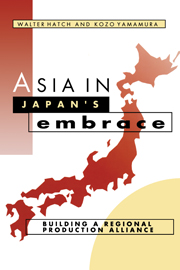Preface
Published online by Cambridge University Press: 05 February 2012
Summary
At the turn of the last century, the United States was planted firmly in the Asia-Pacific region. It had opened trade relations with China and Japan, explored a number of islands, and even laid claim to its own archipelago, the Philippines. Puffed up with patriotic pride, expansionists such as Chauncey Depew crowed that the Pacific Ocean had become an “American lake” dominated by US merchant vessels and warships. Asia's fate, they believed, was America's.
As a new century unfolds, US aircraft carriers laden with sailors and fighter jets steam in and out of Tokyo Bay, serving as floating symbols of America's now unrivaled military clout in a post-Cold War world. US container ships cruise these waters as well. But they are vastly outnumbered by Japanese vessels carrying automobile parts, machine tools, and myriad electric and electronic products manufactured by Japanese affiliated firms all over the region. We are exaggerating only a little in saying that, in terms of commerce, the “American lake” has all but dried up; a “Japanese lake” is rising in its place.
The ebb and flow of economic power in Asia, the growth center of the world economy, is critically important to everyone inside and outside this region. While the industrialized economies of the world limp along, hoping for a growth rate of 3 percent a year, the industrializing economies of Asia are expanding at phenomenal rates of up to 13 percent.
- Type
- Chapter
- Information
- Asia in Japan's EmbraceBuilding a Regional Production Alliance, pp. viii - xviPublisher: Cambridge University PressPrint publication year: 1996

